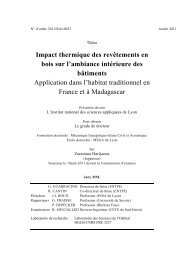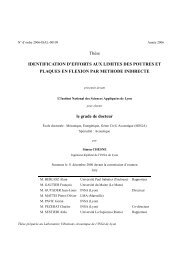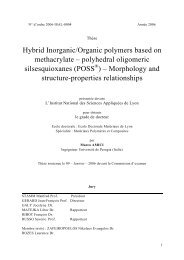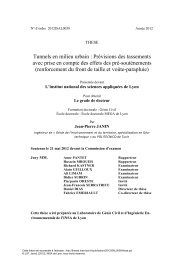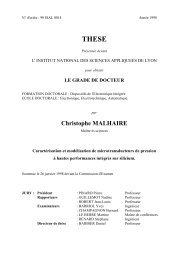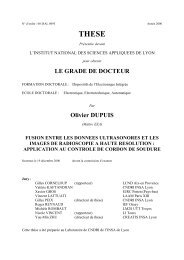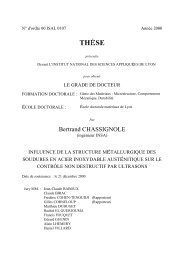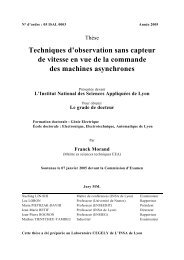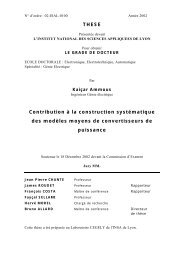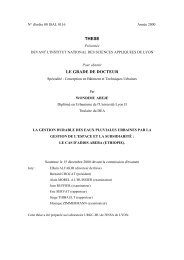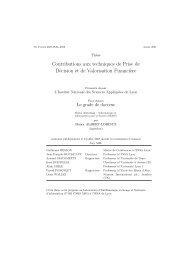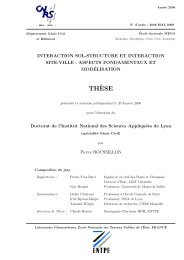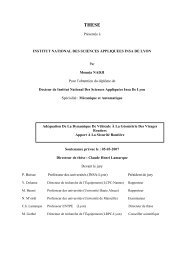Segmentation d'images couleur par un opérateur gradient vectoriel ...
Segmentation d'images couleur par un opérateur gradient vectoriel ...
Segmentation d'images couleur par un opérateur gradient vectoriel ...
Create successful ePaper yourself
Turn your PDF publications into a flip-book with our unique Google optimized e-Paper software.
QUANTIFICATION ET MORPHOLOGIE DE PHASES DE CLINKER PAR ANALYSE D'IMAGE.<br />
level in the local structure). The following different feature families for the classification of alite<br />
and belite crystals are considered:<br />
• Histogram features which describe the grey-level distribution in the analysing<br />
window.<br />
• Features calculated on the neighbourhood matrix [Haralick et al., 1973] which<br />
measure in a limited neighbourhood the coarseness or busyness of a micro-texture.<br />
• Features calculated on the r<strong>un</strong> lengths matrix [Galloway, 1975] which measure the<br />
length, the number and the distribution of the grey-level r<strong>un</strong>s in the analysing window<br />
and allow detection of the degree of homogeneity or heterogeneity.<br />
• Cooccurrence features [Haralick et al., 1973], which describe the repetition of greylevel<br />
changes, measured for pairs of points in a typical distance and direction. Microtextures<br />
and the Macro-textures can be detected preserving the directionality of each<br />
texture.<br />
• Frequency features (repetition rate of a micro-texture) can be calculated by a<br />
frequency transformation (Fourier- or Cosine-transform [Liu et al., 1990]) of the<br />
image window. These features evaluate the distribution of the frequencies and the<br />
directionality of the texture.<br />
The six families group a huge number of characteristic features or <strong>par</strong>ameters. Some of<br />
the <strong>par</strong>ameters are correlated, others are red<strong>un</strong>dant in the different groups and may be excluded.<br />
The <strong>par</strong>ameter signature obtained in this way will be used for the classification of each window.<br />
Discriminating analysis [Rao, 1952]<br />
A combination of the features can be fo<strong>un</strong>d by the Multivariable Discriminating Factorial<br />
Analysis (MDFA). It creates a synthetic index, which allows the best se<strong>par</strong>ation of the two<br />
textures (alite and belite). This index is a linear combination of the texture features and takes into<br />
acco<strong>un</strong>t the whole information. The best results are obtained for a combination of six features. A<br />
larger number does not increase the classification result but only introduces noise to the analysis.<br />
The feature selection depends on the size of the window. The most discriminate feature is the<br />
entropy of the test-window.<br />
The MDFA is a statistical analysis and needs a huge learning database. As database, 30<br />
images with about 3000 test-windows for the two kinds of crystals were chosen. Figure 44 shows<br />
the histogram of the synthetic texture index computed by the MDFA on the learning base. The<br />
distribution shows that the texture index is sufficiently different for the two textures alite and<br />
belite, enabling the classification of the majority of the observation-windows. Note that there is<br />
an <strong>un</strong>certain zone in which the decision is not possible. This zone represents less than 30% of<br />
the total population.<br />
WORLD CEMENT RESEARCH AND DEVELOPMENT 1998 102



